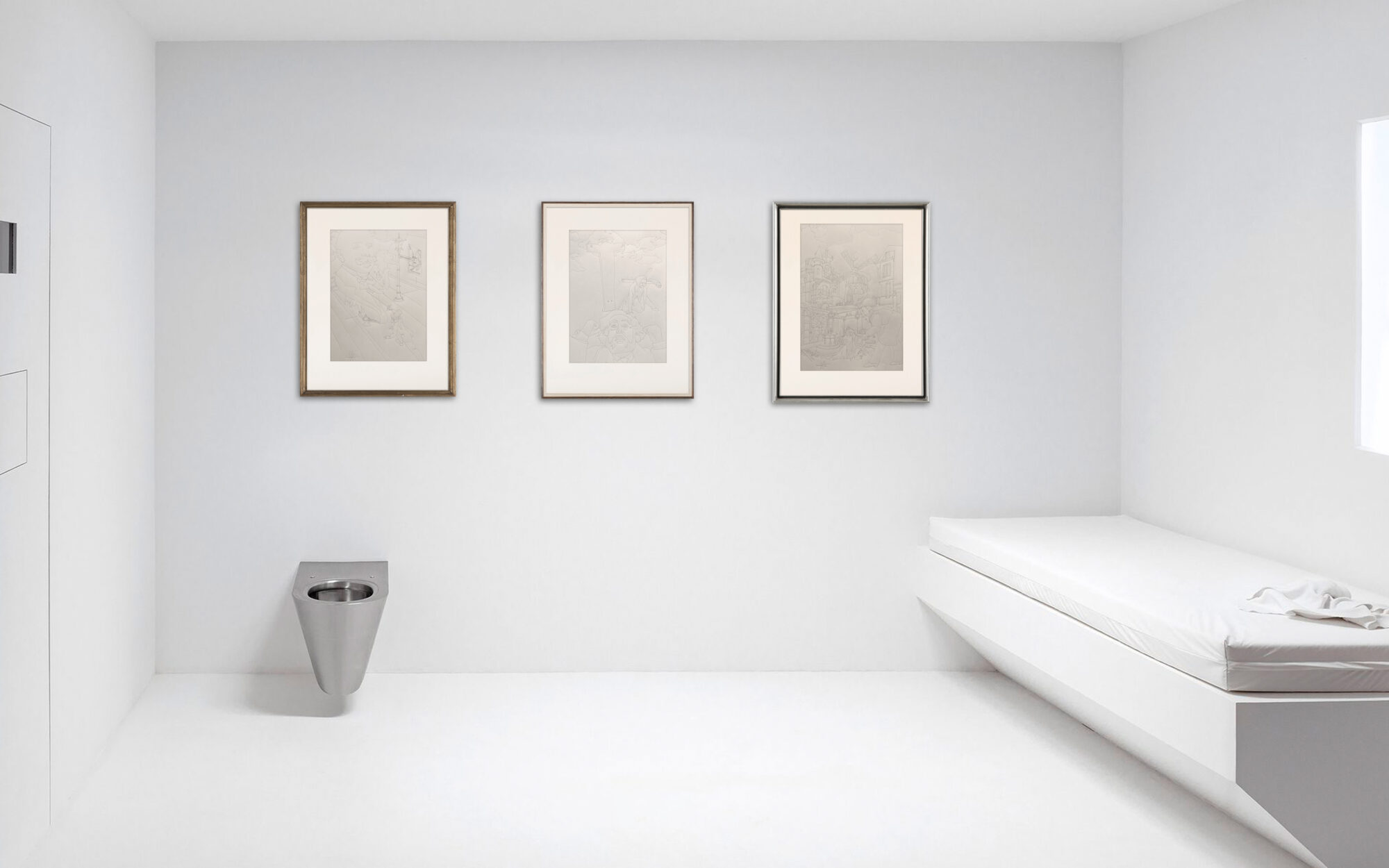
Art exhibition: Illness Drawings (Sjukdomsteckningar)
A collection and exhibition of short stories based on the schizophrenic reality of the artist Ernst Josephson.
In the art exhibition ”Illness Drawings”, the artist Per Josephson develops the illness motifs of his relative Ernst Josephson. Windy nights from the island of Bréhat off the coast of Brittany. Rembrandt and Swedenborg in a battle over the chessboard and Strindberg who goes on an artistic bender to the enchanting voice of soprano Jenny Lind. New works of art that come to life in both virtual and physical form using blockchain technology.
The artist Ernst Josephson (1851-1906) is today one of Sweden’s most celebrated artists. Represented in the foremost museum contexts such as the National Museum, the Gothenburg Museum of Art, and more or less permanently mounted at Waldemarsudde. As the leader of the new artistic influences at the end of the 19th century, Ernst suffered numerous attacks, both internal and external.
”When I sat and read all the letters that are preserved between Ernst and the various groups involved in the Opponents’ fight to renew the view of art in Sweden, Ernst’s vulnerable position as the Opponents’ leader or ‘The Field Marshal’, as he was called, is undeniably apparent,” says Per Josephson.
With his moody temperament and far too big heart, he tries to parry the attacks that soon become too much for him, and he falls hard. In 1887, he packs his painting tools and leaves Sweden in poor condition, washed up on the island of Bréhat off the coast of French Brittany with his last artist friend Allan Österlind and his family.
In the stormy smoke over the barren island, Ernst falls freely into the endless tangle of schizophrenia. After endless nights in the spirit of spiritualism, Ernst lets go and surrenders entirely to the schizophrenic reality. In desperation, Österlind turns to former artist friends in Sweden for help. Eventually, his begging succeeds, and Ernst arrives in Sweden in a fully insane state, where he is later taken care of at the hospital in Uppsala on December 29, 1888.
When Ernst signs himself out of the hospital in Uppsala on April 15, 1889, and takes the train to Stockholm, he has drawn himself out of the absolute bottom of schizophrenia. However, he will never find his old self again, and the remaining years will dissolve into nothingness, offering only a few sparse occasions with a paintbrush in hand until Ernst finally falls into eternal sleep, contently humming his beloved Bellman.
”Several of these drawings hung on the walls during my childhood, and the interesting thing is that I can’t remember experiencing them as crazy or insane during my childhood. The shaky lines and strange figures soon became equally intricate and enchanting stories. These and Ernst’s stories are what I continue to draw now,” says Per Josephson.
As a multidisciplinary artist known for his unique blend of traditional and innovative media in his creations, Per Josephson is now pushing the boundaries of what art is and how it can be experienced further. In his upcoming collection and exhibition, physical drawings, a book, and additional works are combined with virtual editions and metaverse experiences.
Fifty drawings have been digitized and developed with sound and moving images to be experienced and stored in a virtual reality. As a bridge between the physical and virtual, visitors will have the opportunity to experience and explore the art both on-site in Stockholm and through their computer or smartphone.
”I have always been fascinated by the intersection of technology and art,” says Per. ”By creating virtual versions of my physical artworks, I hope to provide a new and immersive experience for a growing platform. We live in a global world and access to art must be expanded.”
The latest collection is strongly linked to the disease schizophrenia that Ernst Josephson suffered from in the final stages of his life. Therefore, a portion of the proceeds goes towards research and support for those who suffer from the disease, in collaboration with the Schizophrenia Association. The exhibition also aims to raise awareness and encourage visitors to empathize with the condition, but exactly how that will work, the artist is tight-lipped about. ”You have to go there and experience it for yourself, even if you do it from your couch at home,” says Per Josephson.
The exhibition will be shown in Stockholm on 9/9 but can also be visited via a metaverse created by Per. The physical exhibition is open to the public, but the virtual experience requires a visit pass in the form of a so-called NFT (Digigrahps); a virtual asset that gives the owner various values and benefits. ”I want to break new ground and democratize the art world” says Per.
APPENDIX
On December 29, 1888, the artist Ernst Josephson was taken into custody by the hospital in Uppsala. There, he was diagnosed with schizophrenia and stayed until April 15, 1889, when he declared himself cured and took the train to Stockholm.
Throughout his illness, he drew frenetically, something that started during his stay on the island of Bréhat off the coast of Brittany in 1887. The drawings are often made on simple paper in ink or pencil/charcoal. Thin, fragile lines that connect figures and events in living formations. The number of drawings is estimated at about a hundred, created under Ernst’s pen during his manic state between 1887 and 1889.
A few years later, Ernst’s artist friend Georg Pauli offered some of these drawings to the National Museum in Stockholm but was met with ridicule by the then-director Gustaf Upmark. He referred to the paper being of too simple a quality and said he ”prefer not to comment” on the drawings.
The drawings consist of thin, simple lines where Ernst visualizes strong motifs in the ”disease visions” that arise vividly in the artist’s strained mind. He often signs his work with the names of deceased artists with whom he engages in eager dialogues, such as Rembrandt, Velázquez, Swedenborg, Jenny Lind, and many more.
”In my opinion, the drawings are fantastic, and I am far from alone. The drawings are still frequently sold today at major auction houses for hefty sums. Recently, I had a conversation with Åmells art dealer on Birger Jarlsgatan, where many of these sales take place, and a funny anecdote came up.
Ernst’s recurring habit of signing with the names of others has caused a lot of problems, resulting in these drawings of illness being some of the most counterfeited artworks on the market,” says Per and continues…
”During the art project 5xJosephson that I carried out in 2021, these drawings appeared in various contexts to now take their rightful place. On the same simple paper, with hopefully equally emotional lines, I have taken my relative Ernst’s drawings further, albeit signed only by me for simplicity’s sake.”
What are NFTs?
NFTs, or Non-Fungible Tokens, (Digigraphs) are unique digital assets that are stored on a blockchain, which is a decentralized, public ledger of transactions. Each NFT represents a one-of-a-kind item, such as a digital artwork or collectible.
What are these NFTs and what do you get from buying one?
We’ve taken one unique physical pencil drawing from the Illness Drawings collection and turned it into 100 unique digital fractals, each the size of one one hundredth of the total canvas. The NFT fractals are stored on the blockchain as unique assets with various utilities.
As a holder of an NFT fractal from the collection: “Fractals of Illness Drawings No. 04 01/01-100/100*, you are entitled to art and artist-related perks. These include early access to IRL exhibitions, and art sales, and exclusive access to a dedicated metaverse, which is a virtual space built by the artist Per Josephson, where you’ll be able to experience art in a whole new way. In the metaverse, NFT holders can interact with each other and digital objects in a simulated environment based on the history and art of Ernst Josephson and the collection Illness Drawings.
Why do you use NFTs?
NFTs represent a new way of proving ownership and guaranteeing certain rights, both for buyers and artists. Free from the restraints of the traditional art world and with all the possibilities of blockchain, new mediums and expressions can be made. Web3 connects communities like never before.
Buying an NFT means that you verifiably own it, as it will be transferred to your digital wallet. From there, you are free to sell or trade it on secondary market places as you wish. There are several solutions to showcasing digital art in physical spaces, and we’ll present some as part of this project.
Are these the only artworks to drop in the collection?
Further NFTs will be dropped as part of the overarching Illness Drawings collection, but each sub-collection is limited and unique.
*Drawing No.= name of drawing
01 = copies of fractals
01 = placement in series of fractals
100 = total amount of fractals



